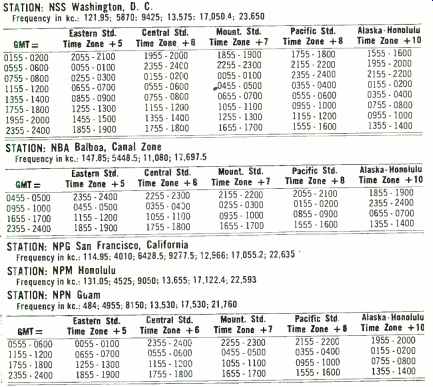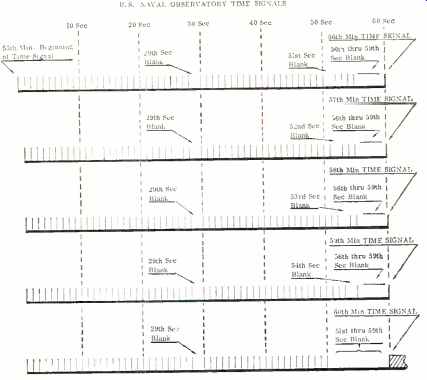(source: Electronics World, Aug. 1963)

By H. CHARLES WOOD
Description, use, and schedules for the "time ticks" that are broadcast on low, medium, and high frequencies.
Editor's Note: Although not as widely known and used as the National Bureau of Standards WWV and WWVH time signals, useful time signals are also broadcast by a number of Navy radio stations to ships around the world. This article discusses these time signals, tells how to interpret them, and gives the broadcast schedules of the stations involved.
JOHN HARRISON of Yorkshire, England is credited with developing the first practical shipboard clock (or chronometer) in 1735, and thus earned a handsome reward of £ 40,000 from the British Parliament. Prior to that date, accurate navigation on the high seas could not be achieved, because one of the major factors of celestial navigation is an accurate knowledge of time; an impossible feat in the days of the Ancient Mariner. This accounted for a seaman's reluctance to venture beyond the sight of land.
It wasn't long after Harrison's invention was made available to sea captains that new problems arose, the most important of which was the inability to predict the daily rate of error of the chronometers when the vessels were away from their home ports for a long period of time. This error is normally applied to the watch-time to determine the correct local time.
A small step forward was made in the 19th century when most of the major ports of the world were equipped with a "time ball" which was dropped from a conspicuous location in the harbor at noon. The sea captains in port would then set their chronometers accordingly. Unfortunately, however, not all port officials had the correct time. The problem of incorrect time, and the consequent error in a ship's position, continued throughout the 19th century, resulting in much loss of life and property, and was not solved until the invention of radio at the beginning of the 20th century.

Table 1. Schedule of the U.S. Naval Observatory time signals.

Fig. 1. Arrangement of "time ticks" as transmitted by stations.
Stations & Schedules
In 1904, U.S. Navy Radio Station NSS, newly established at Washington, D.C., began broadcasting time signals synchronized with the precision clocks at the Naval Observatory.
This was the first significant advancement since Harrison perfected his invention nearly two centuries before, for now at last mariners all over the world could correct their chronometers with a signal of known accuracy.
Throughout the years, the U.S. system of radio time signals has been improved in accuracy and presentation, the power of the transmitters has been increased, new frequencies have been added, and new Naval radio stations have been built.
Today, there is scarcely a spot on the planet that is not within range of at least one of the daily time signals.
Naval Observatory time signals are now being broadcast at numerous times throughout the day by five widely separated Navy radio stations: NSS Washington, D.C,; NBA Canal Zone; NPG San Francisco, California; NPM Honolulu; and NPN Guam. The hours of the transmissions and the frequencies of emission are listed in Table 1. At the top of each tabulation are the call letters, location of the station, and the frequency of transmission in kilocycles. The Greenwich Mean Time (GMT) of transmission is located in the left-hand column, followed by a conversion to the zone times maintained throughout the United States. Local time for any other location can be computed by applying the time zone number to the GMT. For example, Los Angeles, California is located in time zone +8. This means that 8 hours must be subtracted from GMT to obtain the local time of Los Angeles. Thus the 2400 hours midnight time signal will be heard in California at 1600 hours local time (4:00 p.m. for you landlubbers). It will be one hour later if your community is on daylight saving time. World time zone charts are available at U.S. Hydrographie Offices, nautical equipment stores, and most bookshops.
Now let's examine the time signal itself, as it is graphically displayed in Fig. 1. Essentially, the signal is a series of rhythmic c.w. signals or "beeps," beginning 5 minutes before the hour and providing the listener with five separate time checks one at the 56th minute; one at the 57th; one at the 58th; one at the 59th; and one on the hour. Due to mechanical or operator variance, the signal may not necessarily begin at the 55th minute, however, this is of no consequence, since the beginning is not to be used as a marker. As the signal proceeds through the 55th minute, the halfway point is indicated by the omission of the 29th second. As the "beeps" continue, you will also note a blank at the 51st second, followed by signals on the 52nd, 53rd, 54th, and 55th seconds. These four "beeps" following the 51st second is a code reference alerting the listener of the approaching 56th minute time signal. The 55th second c.w. signal is followed by a 4-second silent period, which is ended by the time signal, precisely indicating the 56th minute. This is the end of the first time check.
The 1-second "beeps" continue through the 56th minute as indicated in Fig. 1, with the 29th second blank as in the preceding minute; again denoting the halfway point. As the signal approaches the end of the 56th minute, the 52nd second is omitted (instead of the 51st second as in the preceding check), followed by the 53rd -, 54th -, and 55th second markers, and then by the 4-second silent period. The silent period is ended by the time signal, precisely indicating the 57th minute. During this second time check, the three 1second signals at the 53rd-, 54th-, and 55th-second markers serve as the code reference for the 57thminute check.
This procedure is repeated for the 58th- and 59th-minute time checks with the 53rd and 54th seconds omitted respectively. A long dash, preceded by the 9-second silent period, composed of the omission of the 51st through the 59th second "beep," denotes the hour. The beginning of the long dash indicates the on time." To summarize, the listener need not laboriously count the "beeps" throughout the entire time signal, but only to note the number of second markers preceding each of the 4-second silent periods. If four 1-second indications are heard, he is alerted to the 56th-minute time check. If the listener hears three "beeps" preceding the 4-second blank period, he will know that the 57th minute is coming up, etc. And when he hears the 9-second silent period, he will be ready to set his watch or chronometer to the exact hour.
The time signals transmitted from NSS Washington, D.C. are regulated to an accuracy of 0.01 second. This precision is obtained by observation of the stars, using special telescopes and transits. Accuracy is further enhanced by enclosing the equipment in environmental chambers, which maintain the delicate instruments at a constant temperature and humidity, thereby minimizing metal distortion. The signals from NBA, NPG, NPM, and NPN are rebroadcast from Washington by automatic relay and are correct to 0.25 second.
Thus we have precise time signals being transmitted by radio at frequent intervals throughout the day on frequencies ranging from 114 kc. in the 1.f. range to 2:3,650 kc. in h.f. range.